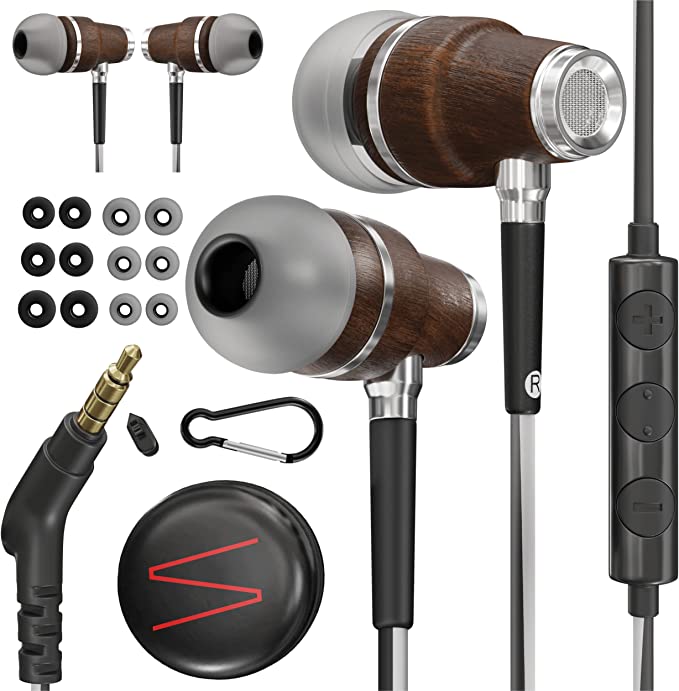Skullcandy Ink'd+ In-Ear Earbuds: Understanding Your Sound - Affordable Audio Science Explained
Update on April 28, 2025, 3:20 p.m.
Sound. It’s arguably one of the most powerful, yet invisible forces shaping our daily experience. It’s the rhythm that gets your feet moving, the voice that connects you across distances, the soundtrack that paints your memories. And in our modern world, much of this personal soundscape is delivered through a ubiquitous piece of technology: the humble earbud. We plug them in, press play, and are instantly transported. But have you ever paused to wonder about the intricate dance of physics and engineering happening within those tiny shells?
Let’s embark on an exploration, using the popular and accessible Skullcandy Ink’d+ wired earbuds as our guide. Forget marketing buzzwords; we’re going on a behind-the-scenes tour to understand the science that allows these little devices—and indeed, most earbuds—to translate silent electrical signals into the rich tapestry of sound that fills our ears. Consider this your backstage pass to the world of personal audio engineering.

Birthplace of the Beat: The Mighty 10mm Dynamic Driver
At the very core of each Ink’d+ earbud lies its heart, its voice: a 10-millimeter dynamic driver. Think of it as a miniature, high-precision loudspeaker, shrunk down to fit comfortably in your ear canal. This is where the magic truly begins. So, how does this tiny marvel work?
Imagine a microscopic drum kit. The dynamic driver operates on a principle that’s been fundamental to audio for over a century: electromagnetism. When the audio signal (an electrical current representing the music) flows from your phone or player, it travels through a tiny coil of wire attached to a diaphragm—a thin, flexible membrane (like the drum skin). This coil sits within a magnetic field created by a small permanent magnet. As the electrical current fluctuates with the rhythm and pitch of the music, it generates a varying magnetic field around the coil. This interacts with the permanent magnet’s field, causing the coil, and thus the attached diaphragm, to rapidly vibrate back and forth.
This precisely controlled vibration pushes and pulls the air molecules directly in front of it, creating minute pressure waves. And what are these pressure waves? Sound! The driver essentially acts as a sophisticated air pump, recreating the patterns of compression and rarefaction that our ears interpret as bass notes, soaring vocals, and shimmering cymbals.
The “10mm” refers to the diameter of this diaphragm. While driver size isn’t the only factor determining sound quality, it’s significant. A 10mm driver is a common and well-regarded size for in-ear monitors, generally offering a good balance – large enough to potentially move enough air for satisfying bass, yet small enough to fit within the earbud housing and respond quickly for detailed sound. This driver is the foundation, the source of every single sound wave that reaches your eardrum from the Ink’d+.
Painting with Frequencies: The 20Hz-20kHz Sonic Canvas
Now that we know how sound is created, let’s talk about what sounds can be created. The Skullcandy Ink’d+ specifications state a Frequency Response of 20Hz to 20kHz (Hertz to kilohertz). What does this range actually tell us?
Think of the audio spectrum like an artist’s palette, filled with all the possible colors of sound, from the deepest, darkest shades to the brightest, most brilliant hues. Frequency, measured in Hertz (Hz), corresponds to the pitch of a sound – how low or high it sounds. A low frequency like 20Hz represents the deepest bass notes, the kind of sub-bass rumble you might feel as much as hear in electronic music or a pipe organ. At the other end, 20kHz (or 20,000Hz) represents the highest treble frequencies, the delicate sparkle of a cymbal, the high harmonics that give instruments their unique timbre, or the “airiness” in a recording.
Crucially, the 20Hz to 20kHz range closely matches the generally accepted scope of human hearing. While this range might shrink slightly as we age, especially at the higher end, covering this full spectrum is the theoretical goal for any audio device aiming for faithful sound reproduction. It means the Ink’d+ aims to reproduce everything from the lowest thumps to the highest whispers present in your music. Having this wide potential range is like giving the driver a full canvas to paint on, allowing it the possibility of rendering the complete sonic picture intended by the artists and recording engineers. It doesn’t guarantee how well it paints within that range (that’s where tuning comes in), but it ensures the fundamental building blocks, the full spectrum of potential sound “colors,” are accounted for.
The Energy Handshake: Why 16 Ohms Makes Life Easy
Next up in our technical dive is Impedance, listed as 16 Ohms ($\Omega$). This term sounds technical, but its implication for you, the listener, is actually quite straightforward and beneficial. Impedance, in electrical terms, is essentially a measure of how much a circuit resists the flow of alternating current (like an audio signal).
So why should you care about 16 Ohms? Think of it like water flowing through pipes. Low impedance is like a wide, unobstructed pipe – it allows energy (the audio signal’s power) to flow through easily. High impedance is like a narrow, constricted pipe, requiring more pressure (voltage) to get the same amount of flow (current/power).
Earbuds like the Ink’d+ with low impedance (typically anything under 32 Ohms is considered low for headphones) are designed specifically to work well with portable devices like smartphones, laptops, tablets, and MP3 players. These devices usually have relatively low-power headphone outputs. The 16-Ohm rating means the Ink’d+ doesn’t demand much electrical “pressure” to reach a good listening volume and operate efficiently. You don’t need a bulky, external headphone amplifier to power them properly. They perform an easy “energy handshake” with your everyday gadgets. This translates directly to user convenience: plug them in, and they just work, delivering adequate sound levels without fuss.
Crafting Your Personal Sound Bubble: The Art of Passive Noise Isolation
One of the advertised features of the Ink’d+ is its “Noise Isolating Fit.” This is a prime example of clever physical design rather than complex electronics. How does it work to hush the outside world?
The key lies in the in-ear design itself, combined with the soft, pliable silicone ear gels (the box typically includes Small and Medium sizes). When you insert the earbud correctly, the ear gel is designed to conform to the unique shape of your ear canal entrance, creating a physical seal. Imagine closing a window to block out noisy street traffic – that’s essentially what passive noise isolation does for your ears. It acts as a physical barrier, significantly reducing the amount of ambient sound waves (especially higher-frequency sounds like chatter or keyboard clicks) that can travel through the air and reach your eardrum.
It’s crucial to understand that this is passive isolation – it works by physically blocking sound. This is different from Active Noise Cancellation (ANC), a more complex and power-hungry technology found in more expensive headphones. ANC uses microphones to listen to external noise and then electronically generates an “anti-noise” sound wave to cancel it out. Passive isolation, as employed by the Ink’d+, is simpler but can be surprisingly effective, particularly when you achieve a good seal. Finding the right ear gel size is paramount here; a poor fit means gaps, and gaps mean external noise leaks in, diminishing the isolation effect and potentially impacting the bass response you perceive. It puts a degree of control over your listening environment directly in your hands (or ears!).
Keeping it Clean: A Quick Look at THD (Total Harmonic Distortion)
Among the specifications, you’ll find “THD: \<3% at 1KHz.” THD stands for Total Harmonic Distortion. While it sounds complex, the core idea is about sound purity or fidelity. When an audio component like an earbud driver reproduces a sound signal, it ideally should output exactly what was input, just louder. In reality, all components introduce some tiny amount of distortion – extra, unwanted frequencies (harmonics) that weren’t in the original signal.
THD measures the level of these added harmonic distortions relative to the original signal, expressed as a percentage. The “\<3% at 1KHz” spec means that when reproducing a standard test tone of 1 kilohertz (a frequency roughly in the middle of the human hearing range), the Ink’d+ is designed to add less than 3% of harmonic distortion energy compared to the original signal’s energy.
Think of it like making a photocopy. A perfect copy (0% THD) would be indistinguishable from the original. A copy with some THD might look slightly fuzzier or have barely perceptible artifacts. Is \<3% good? In the world of high-fidelity audio, engineers strive for much lower numbers (often well below 0.1%). However, for budget-friendly consumer earbuds, a THD specification like this indicates a design target focused on maintaining reasonable clarity and avoiding obvious, unpleasant distortion during normal listening, rather than aiming for absolute analytical accuracy. It’s a measure suggesting the sound should be relatively clean, without excessive unwanted additions generated by the earbuds themselves within that tested frequency.
The Supporting Cast: Mic, Controls, and the Enduring Wire
Beyond the core components shaping the sound itself, the Ink’d+ incorporates features designed for practical, everyday usability. The inclusion of an in-line microphone transforms the earbuds from purely listening devices into communication tools, allowing you to take hands-free calls without reaching for your phone. User feedback often mentions acceptable clarity for callers, making them functional for quick conversations.
Complementing the microphone are the call and track controls, typically a single button integrated near the mic. This simple interface usually allows you to play or pause your music, skip tracks, and answer or end phone calls with intuitive clicks. It’s a small convenience that significantly enhances the user experience, keeping your phone tucked away safely while you manage your audio and calls on the go.
Finally, let’s not overlook the wired 3.5mm connection. In an increasingly wireless world, the traditional headphone jack might seem old-fashioned, but it retains distinct advantages. It requires no charging, eliminating battery anxiety entirely. The connection is typically rock-solid and stable, free from the potential dropouts or interference sometimes encountered with Bluetooth. It offers zero latency, meaning there’s no delay between what you see on screen (like in a video or game) and what you hear, which can be crucial for some applications. And, provided your device still has a 3.5mm port, compatibility is generally universal. Of course, the trade-off is the physical tether, the potential for tangled cables, and the declining prevalence of the jack on newer smartphones. It represents a choice for simplicity and reliability.
One small practical note often surfaced by users regarding earbuds of this type is the lack of clear L/R (Left/Right) markings on the earbuds themselves. While seemingly minor, correct stereo placement is important. Music is often recorded and mixed in stereo to create a sense of space and directionality – placing instruments or effects specifically in the left or right channel. Wearing the earbuds reversed can flatten this soundstage or make the mix sound unnatural, a reminder that even small design details impact the final listening experience.
Conclusion: The Accessible Symphony of Science
So, there you have it – a peek under the hood of the Skullcandy Ink’d+ earbuds. We’ve journeyed from the vibrating heart of the dynamic driver, across the full spectrum of sound frequencies, understood the electrical handshake of impedance, explored the physics of noise isolation, and even touched upon the measure of sound purity.
What becomes clear is that even in an affordable, everyday product like this, there’s a fascinating interplay of established scientific principles and clever engineering. The Ink’d+ aims to deliver the core requirements of personal audio – reproducing a wide range of sound, being easy to power, offering some respite from external noise, and providing basic communication and control features – by leveraging these fundamental audio technologies.
It’s a testament to how far audio engineering has come that such capabilities are accessible at this price point. Of course, budget-friendly electronics inherently involve trade-offs in materials, manufacturing precision, and perhaps long-term durability compared to premium gear. But understanding the science inside allows us to appreciate what is being delivered. It transforms a simple purchase into an encounter with applied physics. The next time you pop in your earbuds, take a moment to appreciate the tiny, complex symphony of science working tirelessly, right there in your ears, to bring your world to life with sound.



























































